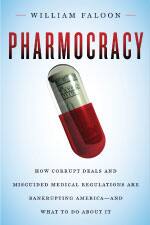Life Extension Magazine®
A fierce debate is raging as to who will pay for this nation’s skyrocketing sick-care costs. Private companies have scaled back sharply on health care coverage they used to provide. Employees now pay an increasing percentage of their medical insurance premiums, along with higher deductibles, co-pays, and no-pays (i.e., exclusions). Many businesses provide no health coverage to their employees.1,2 Based on the median income in the United States, the typical family cannot come close to paying the staggering cost of health care themselves. It seems rather odd, but since neither business nor individuals can afford today’s sick-care costs, the burden is increasingly being borne by the sector least able to pay, i.e., heavily indebted state and federal governments. The federal government is already saddled with a huge unfunded Medicare liability. No one has figured out where the money will come from to cover these future health care costs. To put this into context, the most recent estimate of Medicare’s unfunded liability is $24.6 trillion.3 Yet total federal tax revenues taken in annually (which include Medicare premiums) are only around $2 trillion.4,5 As our current President stated last year, we are approaching a point where the government will have to spend more money on Medicare than every other federal program combined!6 The most recent government report states that the Medicare hospital trust fund will go bankrupt five years sooner than what was projected a mere twelve months earlier.7 None of these numbers are reliable. Congress and agency bureaucrats use all kinds of accounting gimmicks when projecting Medicare’s date with insolvency. For instance, the unfunded Medicare liability was pegged at $37 trillion in 2009.8 That means the government should have had $37 trillion in a trust fund earning interest in order to meet its future obligations. But politicians constantly manipulate the numbers. The latest report reduced Medicare’s official unfunded liability to $24.6 trillion. The reason for these wild fluctuations is that in any given year, officials can create “assumptions” out of thin air, like assuming doctors will take major pay cuts. Congress has not enacted these pay cuts, but bureaucrats pretend they do in order to understate Medicare’s true unfunded liability.9
What no one in government understands is that health care costs are set to skyrocket even further as new drugs the FDA is app-roving are costing around $100,000 per patient.10-12 Be it $24.6 trillion or $37 trillion, the government does not have the money to cover its Medicare obligations. And Medicaid, which provides health care for lower income people, also has trillions of dollars of unfunded liabilities that are being paid with tax and newly issued debt dollars.13 Why Aren’t These Criminal Acts Being Prosecuted?Bernard Madoff was sentenced to 150 years in prison because he took investors’ money and diverted it to other purposes. The federal government forced Americans to pay Medicare premiums their entire lives. Instead of those premiums being placed in a reserve fund for future use, they were squandered on whatever was most politically expedient at the time, which included overpaying those with the right connections. While Madoff will spend the rest of his life incarcerated, no one talks about bringing civil or criminal charges against those responsible for the largest Ponzi scheme in the history of the human race, i.e., Medicare with its $24.6 trillion of admitted unfunded liabilities. Like the federal government, many local and state governments have also operated a Ponzi scheme of unfunded pension and health care liabilities they cannot pay.14-16 Since the federal government is mathematically insolvent, it seems ludicrous to assume that exorbitant sick-care costs can be resolved by any level of government. While politicians aimlessly point fingers as to who should pay America’s medical bills, please remember that there is a real- world solution. Health care in the United States is so tightly regulated that it in many ways resembles the inefficiencies of Maoist China, where the economy was suffocated by erratic and illogical governmental decrees. As China lifted its regulatory stranglehold, prosperity flourished. It’s time for US leaders to follow China’s example and stop over-regulating medicine!
Even I Was Shocked!For the enlightenment of new members, please know that the Life Extension Foundation® has sounded the alarm bells since the early 1980s about the health care cost crisis that must now be confronted. We said that unless the shackles of regulation are removed, this nation faced inevitable economic insolvency with little in the way of cures being found for age-related diseases. I have written dozens of articles and made hundreds of media appearances attacking today’s broken health care system. I was not aware until recently, however, of how much my own health insurance premiums had gone up, since I was covered under a group plan. For me, my wife, and two children, Life Extension is paying a staggering $17,000 per year! Since our group plan insures over 300 people, we obtain a considerable discount off the individual rate—yet the premiums, deductibles, co-pays, and no-pays are worse than ever. I’d like to think Life Extension is the most efficiently run organization in the world. We can, at the moment, afford these outrageous health insurance premiums for our dedicated employees. But I know many businesses and individuals cannot, and certainly not the government, which is unable to pay for what it is already on the hook for. We Have Been Deceived…Look back over the past 30 years and ask how many cures for the diseases of aging have been found? One can argue the number is near zero!
Americans have paid outlandish prices for prescription drugs under the guise that pharmaceutical profits would fund research leading to medical breakthroughs. The problem is that real-world discoveries have not manifested. One can point to some treatments that prolong patient survival, but these are offset by lethal side effects inflicted by fraudulently approved therapies.17-19 The fact is that few real cures have occurred despite Americans spending more health care dollars than anyone else. Unregulated medicine has made considerable strides, but the majority of the population does not know about these approaches, and vested financial interests have spent billions to ensure that the media, politicians, and bureaucrats continue suppressing them. We have been deceived by those who associate regulations with beneficial outcomes. As it relates to medical progress, the opposite has occurred, i.e., excessive regulation is causing millions to suffer and die needlessly while health care costs skyrocket.20 Few understand that the underlying purpose of regulations is to provide a government-protected advantage to the group favoring the regulation. It’s not about how a regulation will protect the public, but a matter of how it can financially benefit a special interest.21 An often-cited example is the petition drug maker Wyeth filed with the FDA asking that a natural human form of estrogen called estriol be banned.22,23 The female hormone drugs Wyeth is selling (Premarin® and PremPro®) have been shown to inflict all kind of lethal side effects.24-31 Instead of spending money on research to come up with safer forms of estrogen (such as combining natural estrogens with indole-3-carbinol),32-34 it was much cheaper to persuade political hacks at the FDA to outlaw the competition (i.e., bioidentical estriol hormone compounds).35 Pharmaceutical companies have spent enormous dollars persuading the FDA to re-classify nutrients like pyridoxamine as prescription drugs so that they can monopolize them for their own economic benefit.36 If it were not for aggressive letter-writing campaigns to Congress by consumers, all dietary supplements would be expensive prescription drugs by now. FDA—Failure, Deception, and AbuseIn 2010, a 498-page book was published exposing how FDA over-regulation has destroyed citizens’ health and this nation’s finances. Many more pages could be added based on what we have published over the past year alone.
The magnitude of the artificially inflated costs are beyond obscene. For example, an increasingly popular prescription drug in the United States is a testosterone ointment called AndroGel®. Last time we checked, pharmacy chains sell a one-month supply for $348. Many men who try it will continue it each month for the rest of their lives. The cost of the active ingredient in AndroGel® is around $4. It costs a few more dollars to put it into ointment form under good manufacturing practices. So for less than $15 retail, consumers could purchase the same amount of testosterone as is in AndroGel®—if it were not for FDA over-regulation. Even though transdermal testosterone delivery technology has been known for decades, and the patent for bioidentical testosterone expired a long time ago, the FDA only allows a chosen few pharmaceutical companies to sell it. When a compounding pharmacy tries to develop more efficient ways to make testosterone creams, FDA inspectors use existing regulations to stop them. The regulations mandate that individually compounded drugs be made from scratch. If a pharmacy tries to produce larger quantities in bulk, it is no longer classified as “compounded” according to FDA regulations and is therefore illegal.37 In this Orwellian tragedy, the annual cost of regulated AndroGel® comes to $4,176 whereas the same amount of topical testosterone in an unregulated environment would drop to only $180 a year. Regulated testosterone thus costs 23 times more than free- market testosterone. And look who pays for it! If you have health insurance, you will likely face a $25-50 co-pay each month, while your insurance company is fleeced for the balance. If you are a low income individual and don’t have insurance, there are government programs (like Medicaid) that will pay the full retail price of AndroGel®. If you are not indigent and have no insurance, then you are stuck with the entire tab. Be you a taxpayer, co-payor, or out-of-pocket payer your finances are being eaten away by these absurd regulations. Is it any wonder why medical insurance premiums are increasing so sharply? Consumers have to band together to demand Congress introduce emergency legislation that repeals the absurd over-regulation of medicine that exists today. I have written a new book titled Pharmocracy that details how egregious pharmaceutical company profits are protected by regulations, and how these vested interests will go to any corrupt length to ensure these regulations are perpetuated no matter how inane they are.38,39 How Regulated Costs Add UpInstitutionalized corruption artificially inflates the cost of virtually every health care service. Going back to the AndroGel® example, we estimate that more than 80 million American men could benefit by restoring their testosterone levels to youthful ranges.40 If these men are forced to use only FDA-approved testosterone drugs, the excess cost to the United States will be $319 billion each year for this one drug. It used to be just a few years ago that when the entire federal deficit reached $300 billion, the public and some politicians complained. Yet the overpayment Americans are stuck with for this one class of drug (AndroGel® and others) because of FDA over-regulation may exceed previous federal deficits unless the law is amended. When one considers there are thousands of medically related products and services that are artificially inflated by senseless regulations, it becomes clear that radical change is required to avoid an economic meltdown.
|
Even Compounded Testosterone Costs Too MuchAs stated earlier, FDA regulations prohibit compounding pharmacies from making production-scale batches of popular drugs. Each compounded drug must be individually formulated by a licensed pharmacist. The result is that the labor involved in making a compounded drug comprises more than what the active ingredient costs. But there are additional regulations that add even greater costs. Consumers require a prescription to buy compounded testosterone just like they do with FDA-approved testosterone. While competent physician supervision can enhance the safety and efficacy of a testosterone replacement program, the frank reality is that the majority of prescriptions for drugs like AndroGel® are not prescribed by physicians who understand how to optimally manage hormone replacement in men. Seldom are estrogen levels monitored to protect against estrogen overload that can occur when too much testosterone converts (aromatizes) into estrogen in an aging man’s body.41,42 An advantage with compounded testosterone is that if a physician knows how to write a prescription for it, they often have received training on follow-up monitoring. Compounded testosterone cream can be obtained for less than $30 a month, compared to the $348/month price for AndroGel®. Either form can contain the same amount of bioidentical testosterone. Compounded testosterone cream is 91% less expensive than FDA-protected drugs, yet compounded testosterone is still twice as expensive as it needs to be because of governmental over-regulation. In dealing with runaway health care costs, a solution is to make drugs like testosterone available to men over age 40 without the need of a doctor’s visit. There have been companies that have physicians review blood tests over the phone and prescribe testosterone, but FDA and state licensing boards have shut many of these down.43 Corrupt regulations ensure that efficiencies that would slash health care cost (at the expense of pharmaceutical profits) are outlawed. Simple Solution to Avert Economic RuinationLife Extension initiated a petition drive back in the 1980s to allow individual Americans to “opt-out” of the FDA’s regulatory umbrella. Our rationale was that this would provide consumers with more advanced treatments at lower prices.
Hundreds of our enlightened members petitioned, requesting liberation from the FDA stranglehold. The public, Congress, and media were apathetic at that time. The FDA was far from lethargic. They responded to our petition in a way that resembled an angry hornet’s nest when disturbed (or how some dictators respond to street protestors). The notion that we dared challenge the FDA’s absolute authority resulted in years of legal battles in which the FDA did everything in its power to destroy us.44 Move forward to today, and the political climate has turned around. The health care cost crisis we long ago predicted has evolved into a harsh reality no one can ignore. It is mathematically impossible to solve it by forcing one group to pay regulated medicine’s inflated costs. The only salvation are the free-market reforms we long ago drafted. Our proposal is quite simple. Amend the law to allow good manufacturing practice (GMP)-certified facilities to produce generic prescription drugs that do not undergo the excessive regulatory hurdles that force consumers to pay egregiously inflated prices. To alert consumers when they are getting a generic whose manufacturing is not as heavily regulated as it is currently, the law would mandate that the label of these less-regulated generic drugs clearly states: “This is not an FDA-approved manufactured generic drug and may be ineffective and potentially dangerous. This drug is NOT manufactured under the same standards required for an FDA-approved generic drug. Purchase this drug at your own risk.” By allowing the sale of these less costly generics, consumers will have a choice as to what companies they choose to trust. Equally important in our proposals is allowing consumers to be told about the off-label benefits of prescription drugs, such as the extensive body of evidence that metformin may help prevent type 2 diabetes45,46 (and not just treat it) and that metformin may also prevent and help treat certain cancers.47-54 A concern critics raise regarding this free market solution is safety. Who will protect consumers from poorly made generic drugs, they ask? First of all, there will be the same regulation of these drugs as there are with GMP-certified supplement makers. FDA inspectors will visit facilities, take sample products, and assay to ensure potency of active ingredient and dissolution. Laboratories that fail to make products that meet label claims would face civil and criminal penalties from the government.
Secondly, there is no incentive not to provide the full potency of active ingredient in these less regulated generic drugs. The price of the active ingredients makes up such a small percentage of the overall cost that a manufacturer would be idiotic to scrimp on potency.55 Companies that foolishly make inferior generics will be viciously exposed by the media, along with the FDA, consumer protection groups, and even prescribing physicians, who will be suspicious if a drug is not working as it is supposed to. Companies producing inferior products will be quickly driven from the marketplace as consumers who choose to purchase these lower-cost generics will seek out laboratories that have reputations for making flawless products. Substandard companies would not only be castigated in the public’s eye, but face civil litigation from customers who bought the defective generics. When one considers that GMP-certified manufacturing plants can cost hundreds of millions to set up, a company would guarantee itself future insolvency if it failed to produce generic drugs that met minimum standards. Pharmaceutical Company PropagandaNo matter how many facts show that free market generic drugs can be made safe, there are alarmists who believe that even if one person suffers a serious adverse event because of a lower-cost generic drug, then the law should not be amended to allow the sale of these less regulated products. What few understand is that enabling lower-cost drugs to be sold might reduce the number of poorly made drugs. The reason is that prescription drug counterfeiting is a major issue today.56 Drugs are counterfeited because they are so expensive. Yet in the free market environment we espouse, a month’s supply of the popular cholesterol-lowering drug like simvastatin would sell for only $3. It is difficult to imagine anyone profiting by counterfeiting it. So amending the law to enable these super low-cost drugs to be sold might reduce the counterfeiting that exists right now. Another reason these less regulated generics will do far more good than harm is that people who need them to live will be able to afford them. The media has reported on heart-wrenching stories of destitute people who are unable to pay for their prescription drugs. They either do without or take a less-than-optimal dose. The availability of these free-market generics will enable virtually anyone to be able to afford their medications. Those who think generic drugs are safe today should be aware of isolated instances when improperly made active ingredients make it into prescription drugs sold in US pharmacies. These defective ingredients often emanate from FDA-approved manufacturers in China and India. The FDA gives false assurances that these government-approved laboratories are safe. The reality is that the FDA can only inspect each Chinese drug-making factory at best only once every 13 years.57 So the protection consumers think they have today is a facade. I would feel more comfortable buying generics from a company that had its own inspectors in offshore manufacturing facilities as opposed to relying on meaningless FDA rhetoric. As this Article Was Being Finalized…As this article was being finalized, news broke that the FDA had just granted an exclusive monopoly to a company to sell a non-patented progesterone drug that prevents premature births.58 Healthy women naturally secrete huge amounts of progesterone during pregnancy that helps maintain their uterine lining. To protect against premature births and miscarriages in women at risk, enlightened doctors have for decades prescribed progesterone medications that were made by state-licensed compounding pharmacies. The cost per injection was around $20. By granting orphan drug status to one company (KV Pharma-ceutical), FDA rules banned all other forms of progesterone for this indication. The immediate impact was that the cost per injection skyrocketed to $1,500—or as much as $30,000 for a full-term pregnancy.59 An uprising over this price gouging forced the FDA to back down and state it “does not intend to take enforcement action against pharmacies that compound hydroxyprogesterone caproate.” What the FDA is saying is that while it has the discretion to arrest compounding pharmacists for making this drug, it does not “intend to” do so. After the FDA made this announcement, KV Pharmaceutical reduced the price to $690 per injection—which is still more than 34 times its previous free market price. It is unclear how private insurance and Medicaid will determine whether to pay $690 per injection for the version FDA rules state is the only one that can be legally sold or continue paying for the much lower-cost compounded version. Women who are denied access to this drug because of the regulatory quagmire face increased risks they will deliver pre-term babies. In these cases, the costs for intensive neonatology care can run into the hundreds of thousands of dollars per premature-born baby, a price often borne by Medicaid or private insurance. No country on earth can afford this kind of institutionalized corruption, where the chosen few pharmaceutical companies favored by the FDA reap extortionist profits as the nation collapses into a financial abyss. This rare instance in which public backlash forced the FDA to back away from protecting a pharmaceutical company’s obscene profit reveals that citizens have the power the save this country from financial Armageddon. Fight Back Against This Institutional CorruptionThe United States of America faces a health care cost crisis that will render Medicare, Medicaid, and many private insurance plans insolvent. The shocking details about this country’s inability to fund future medical costs are no longer confined to the pages of Life Extension Magazine®. You are reading about them virtually every day in the mainstream media.60,61 When terrorists attacked the United States in 2001, there were patriotic Americans who enlisted in the armed services. Many lost their limbs, their vision, and their lives. No one has to engage in physical combat to save this country from the institutionalized inefficiencies and corruption that plague today’s disease-care system. My new book Pharmocracy presents irrefutable logic to reform today’s broken health care system. The cover price for each copy of Pharmocracy is $24. Life Extension members obtain it at a 60% discount and pay only $9.60. We are offering four copies of Pharmocracy to Life Extension members for only $32 (or $8 each). The reason we want you to purchase four copies is so you can send a copy to your Representative and two Senators. We believe if enough citizens send Pharmocracy to Congress, that our leaders will be forced to recognize the obvious free-market solutions to today’s broken health care system. To order one or four copies of Pharmocracy today call 1-800-544-4440. For longer life,
William Faloon | |||
| References | |||
| 1. Available at: http://www.sciencedaily.com/releases/2009/08/090818182051.htm. Accessed March 24, 2011. 2. Available at: http://www.csmonitor.com/2003/1028/p01s02-usec.html. Accessed March 24, 2011. 3. Available at: https://www.cms.gov/ReportsTrustFunds/downloads/tr2011.pdf. Accessed July 1, 2011. 4. Available at: http://www.gao.gov/financial/fy2010/10frusg.pdf. Accessed March 24, 2011. 5. Available at: http://www.economicsjunkie.com/the-coming-us-tax-receipt-shortfall/. Accessed July 14, 2011. 6. Available at: http://www.whitehouse.gov/the_press_office/remarks-by-the-president-to-a-joint-session-of-congress-on-health-care. Accessed March 24, 2011. 7. Available at: http://waysandmeans.house.gov/News/DocumentSingle.aspx?DocumentID=244984. Accessed July 1, 2011. 8. Available at: http://www.forbes.com/2009/05/14/taxes-social-security-opinions-columnists-medicare.html. Accessed March 24, 2011. 9. Available at: http://www.cms.gov/ReportsTrustFunds/Downloads/2011TRAlternativeScenario.pdf. Accessed July 1, 2011. 10. Available at: http://www.nytimes.com/2011/03/26/business/26drug.html. Accessed June 21, 2011. 11. Available at: http://www.nytimes.com/2008/07/06/health/06avastin.html. Accessed June 21, 2011. 12. Available at: http://www.usatoday.com/yourlife/health/medical/cancer/2010-11-18-provenge-medicare_N.htm. Accessed June 21, 2011. 13. Available at: http://www.glgroup.com/News/If-you-think-health-care-and-Medicare-are-problems-consider-long-term-care-and-Medicaid.-30757.html. Accessed March 24, 2011. 14. Available at: http://www.heritage.org/research/reports/2005/10/the-economic-and-fiscal-effects-of-financing-medicares-unfunded-liabilities. Accessed March 24, 2011. 15. Available at: http://biggovernment.com/publius/2011/07/05/the-compensation-monster-devouring-cities/. Accessed Mar 24, 2011. 16. Available at: http://www.economist.com/node/13983688?story_id=13983688. Accessed March 24, 2011. 17. Available at: http://yourwisdom.yahoo.com/your-health/avastin-cancer-treatment-drug-actually-raises-risk-death-article-acid.html. Accessed March 24, 2011. 18. Available at: http://www.pcrm.org/newsletter/aug10/diabetes_drugs.html. Accessed March 24, 2011. 19. Ranpura V, Hapani S, Wu S. Treatment-related mortality with bevacizumab in cancer patients: a meta-analysis. JAMA. 2011 Feb 2;305(5):487-94. 20. Available at: http://rutherfordtimesonline.com/2010/03/09/the-audacity-of-freedom-government-regulation-of-the-pharmaceutical-industry-harms-more-than-helps. Accessed March 24, 2011 21. Available at: http://www.progressiveradionetwork.com/health-headlines/2010/7/16/special-report-pharmaceutical-profit-big-government-and-bias.html. Accessed March 24, 2011. 22. Available at: http://www.anh-usa.org/access-to-estriol-2/. Accessed March 24, 2011. 23. Available at: http://iacprx.convio.net/site/DocServer/Wyeth_Campaign_Fact_Sheet_0408.pdf?docID=3881&JServSessionIdr004=ibxg9a4i53.app214b. Accessed July 15, 2011. 24. Rossouw JE, Anderson GL, Prentice RL, et al. Risks and benefits of estrogen plus progestin in healthy postmenopausal women: principal results From the Women’s Health Initiative randomized controlled trial. JAMA. 2002 Jul 17;288(3):321-33. 25. Slatore CG, Chien JW, Au DH, Satia JA, White E. Lung cancer and hormone replacement therapy: association in the vitamins and lifestyle study. J Clin Oncol. 2010 Mar 20;28(9):1540-6. 26. Cushman M, Kuller LH, Prentice R, et al. Estrogen plus progestin and risk of venous thrombosis. JAMA. 2004 Oct 6;292(13):1573-80. 27. Beral V. Breast cancer and hormone-replacement therapy in the Million Women Study. Lancet. 2003 Aug 9;362(9382):419-27. 28. Anderson GL, Judd HL, Kaunitz AM, et al. Effects of estrogen plus progestin on gynecologic cancers and associated diagnostic procedures: the Women’s Health Initiative randomized trial. JAMA. 2003 Oct 1;290(13):1739-48. 29. Manson JE, Hsia J, Johnson KC, et al. Estrogen plus progestin and the risk of coronary heart disease. N Engl J Med. 2003 Aug 7;349(6):523-34. 30. Shumaker SA, Legault C, Rapp SR, et al. Estrogen plus progestin and the incidence of dementia and mild cognitive impairment in postmenopausal women: the Women’s Health Initiative Memory Study: a randomized controlled trial. JAMA. 2003 May 28;289(20):2651-62. 31. Chen CL, Weiss NS, Newcomb P, Barlow W, White E. Hormone replacement therapy in relation to breast cancer. JAMA. 2002 Feb 13;287(6):734-41. 32. Nakamura Y, Yogosawa S, Izutani Y, Watanabe H, Otsuji E, Sakai T. A combination of indol-3-carbinol and genistein synergistically induces apoptosis in human colon cancer HT-29 cells by inhibiting Akt phosphorylation and progression of autophagy. Mol Cancer. 2009 Nov 12;8:100. 33. Katdare M, Osborne MP, Telang NT. Inhibition of aberrant proliferation and induction of apoptosis in pre-neoplastic human mammary epithelial cells by natural phytochemicals. Oncol Rep. 1998 Mar-Apr; 5(2):311-5. 34. Available at: http://www.appliedhealth.com/index.php?option=com_content&view=article&id=107071&Itemid=205. Accessed March 25, 2011. 35. Available at: http://www.anh-usa.org/bioidentical-estriol-still-under-threat/. Accessed March 25, 2011. 36. Faloon W. FDA seeks to ban pyridoxamine. Life Extension Magazine®. 2009 Jul;15(7):7-12. 37. Available at: http://www.fda.gov/NewsEvents/Newsroom/PressAnnouncements/2008/ucm116832.htm. Accessed March 25, 2011. 38. Available at: http://articles.mercola.com/sites/articles/archive/2011/03/22/betrayal-of-consumers-by-us-supreme-court-gives-total-liability-shield-to-big-pharma.aspx. Accessed March 25, 2011. 39. Available at: http://www.pharmalot.com/2007/04/60_minutes_beats_up_big_pharma/. Accessed March 25, 2011. 40. Faloon W. Startling low testosterone levels in male Life Extension members. Life Extension Magazine®. 2010 June; 16(6);7-12. 41. Vermeulen A, Kaufman JM, Goemaere S, van Pottelberg I. Estradiol in elderly men. Aging Male. 2002 Jun;5(2):98-102. 42. Cohen PG. Aromatase, adiposity, aging and disease. The hypogonadal-metabolic-atherogenic-disease and aging connection. Med Hypotheses. 2001 Jun;56(6):702-8. 43. Available at: http://www.acpinternist.org/archives/1999/11/epharm.htm. Accessed March 25, 2011. 44. Kent S. Crime report: Victory over the FDA. Life Extension Magazine®. 1996 Sept. 45. Zinman B, Harris SB, Neuman J, et al. Low-dose combination therapy with rosiglitazone and metformin to prevent type 2 diabetes mellitus (CANOE trial): a double-blind randomised controlled study. Lancet. 2010 Jul 10;376(9735):103-11. 46. Charles MA, Eschwege E. Prevention of type 2 diabetes: Role of Metformin. Drugs. 1999;58 Suppl.1:71-3; discussion 75-82. 47. Libby G, Donnelly LA, Donnan PT, Alessi DR, Morris AD, Evans JM. New users of metformin are at low risk of incident cancer: a cohort study among people with type 2 diabetes. Diabetes Care. 2009 Sep;32(9):1620-5. 48. Bodmer M, Meier C, Krahenbuhl S, Jick SS, Meier CR. Long-term metformin use is associated with decreased risk of breast cancer. Diabetes Care. 2010 Jun;33(6):1304-8. 49. Ben Sahra I, Laurent K, Giuliano S, et al. Targeting cancer cell metabolism: the combination of metformin and 2-deoxyglucose induces p53-dependent apoptosis in prostate cancer cells. Cancer Res. 2010 Mar 15;70(6):2465-75. 50. Rattan R, Giri S, Hartmann L, Shridhar V. Metformin attenuates ovarian cancer cell growth in an AMP- kinase dispensable manner. J Cell Mol Med. 2011 Jan;15(1):166-78. 51. Wang LW, Li ZS, Zou DW, Jin ZD, Gao J, Xu GM. Metformin induces apoptosis of pancreatic cancer cells. World J Gastroenterol. 2008 Dec 21;14(47):7192-8. 52. Memmott RM, Mercado JR, Maier CR, Kawabata S, Fox SD, Dennis PA. Metformin prevents tobacco carcinogen-induced lung tumorigenesis. Cancer Prev Res (Phila Pa). 2010 Sep;3(9):1066-76. 53. Algire C, Amrein L, Zakikhani M, Panasci L, Pollak M. Metformin blocks the stimulative effect of a high-energy diet on colon carcinoma growth in vivo and is associated with reduced expression of fatty acid synthase. Endocr Relat Cancer. 2010 Jun;17(2):351-60. 54. Stanosz S. An attempt at conservative treatment in selected cases of type I endometrial carcinoma (stage I a/G1) in young women. Eur J Gynaecol Oncol. 2009;30(4):365-9. 55. Faloon W. Consumer rape. Life Extension Magazine®. 2002 Apr. 56. Available at: http://www.cmpi.org/in-the-news/in-the-news/growing-problem-of-fake-drugs-hurting-patients-companies/. Accessed March 25, 2011. 57. Bate R. Beware the Risks of Generic Drugs. Wall Street Journal. July 6, 2011. 58. Available at: http://www.fda.gov/NewsEvents/Newsroom/PressAnnouncements/ucm242234.htm. Accessed March 25, 2011. 59. Available at: http://www.suntimes.com/lifestyles/health/4230222-423/company-hikes-preemie-preventive-drug-from-10-to-1500.html. Accessed March 28, 2011. 60. Available at: http://articles.latimes.com/2011/may/13/news/la-pn-medicare-social-security-solvency-20110513. Accessed July 15, 2011. 61. Available at: http://voices.washingtonpost.com/federal-eye/2010/11/postal_service_posts_85_billio.html?nav=rss_email/components. Accessed July 15, 2011. |











